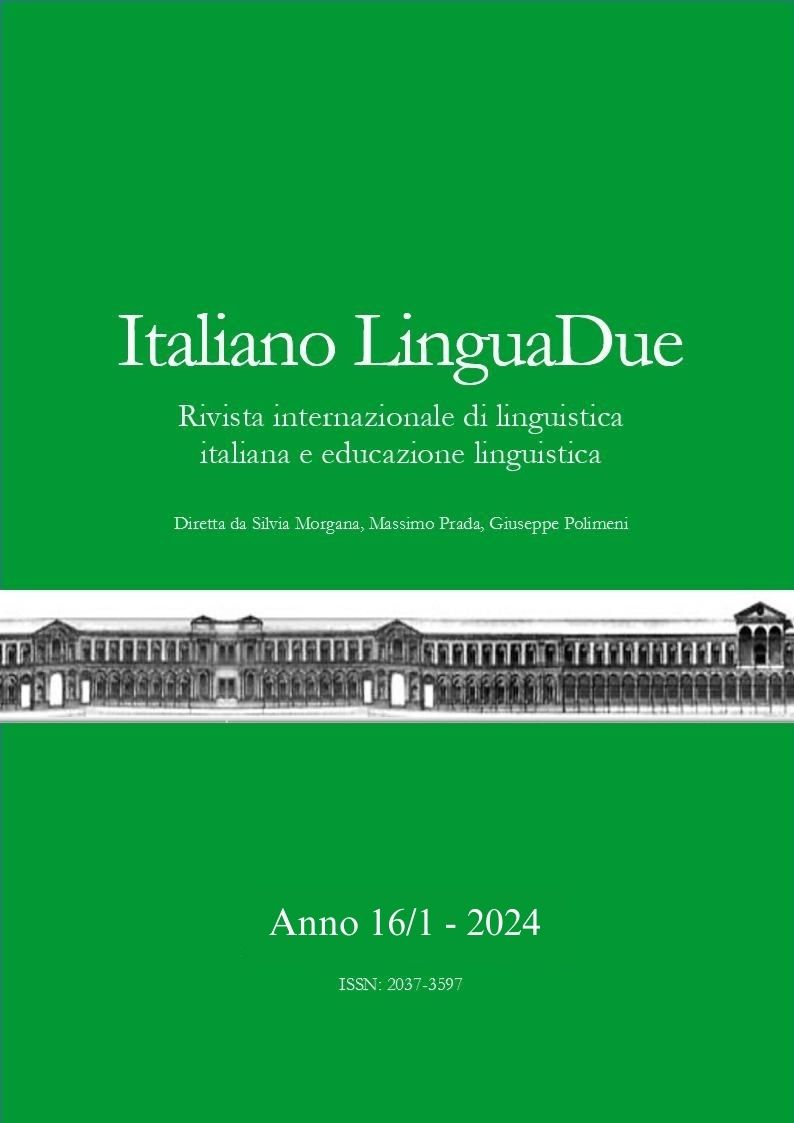LINGUA INGLESE E DISLESSIA: RIFLESSIONI TEORICHE E PROPOSTE OPERATIVE
DOI:
https://doi.org/10.54103/2037-3597/23856Abstract
La dislessia ha ricevuto scarsa attenzione per decenni, ma attualmente sembra suscitare l’interesse dei media e di insegnanti e ricercatori a causa dell’evidente aumento di casi diagnosticati. A questo cambiamento si è giunti grazie all’acquisizione di una maggiore consapevolezza della dislessia come condizione di neurodiversità permanente, e alla comprensione che le sfide ad essa associate possano essere affrontate mediante strumenti e strategie adeguate. Il presente contributo esplora il complesso panorama dell’acquisizione linguistica per gli apprendenti con dislessia, mettendo in luce le specifiche difficoltà legate all’apprendimento della lingua inglese e sottolineando la necessità di approcci didattici personalizzati allo scopo migliorare l'esperienza di apprendimento e favorire un ambiente educativo più inclusivo ed efficace.
Dyslexia and English Language Acquisition: Theoretical Considerations and Practical Recommendations
Dyslexia has received scarce attention for decades, but nowadays it attracts the interest of the media, and of teachers and researchers due to the rising number of diagnosed individuals. This shift in focus is prompted by an increased awareness of dyslexia as a permanent neurodiversity condition and the understanding that its challenges can be addressed through appropriate tools and strategies. This contribution explores the complex landscape of language acquisition for dyslexic learners, shedding light on the specific difficulties posed by learning English and emphasizing the need for tailored teaching approaches to enhance the language learning experience and foster a more inclusive and effective educational environment.
Riferimenti bibliografici
Armstrong T. (2010), Neurodiversity. Discovering the Extraordinary Gifts of Autism, ADHD, Dyslexia and other Brain Differences, Da Capo Press, Cambridge, Mass.
Barr R., Blachowicz, C., Kaufman B. (2002), Reading Diagnosis for Teachers: An Instructional Approach (4th ed.), Allyn and Bacon, Boston.
British Dyslexia Association (2001), Dyslexia in Context, BDA Publication No. X02, London.
Cardona M. (2010), “L’approccio cognitivo-emozionale e il visconte dimezzato”, in Caon F. (a cura di), Facilitare l’apprendimento dell’italiano L2 e delle lingue straniere, UTET, Torino, pp. 26-38.
Chard D. J., Dickson S.V. (1999), “Phonological awareness”, in Instructional and assessment guidelines, 34, 5, pp. 261-270.
Cornoldi C. (a cura di) (2007), Difficoltà e disturbi dell’apprendimento, il Mulino, Bologna.
Davis R., Braun M. (1997), The Gift of Dyslexia, Perigee Books, New York.
Drew C., Egan M., Hardman M. (2002), Human Exceptionality: Society, School, and Family, Allyn and Bacon, Boston.
Gardner H. (1993), Frames of the mind: The theory of multiple intelligences, 10th Anniversary Edition, Basic Books, New York.
Gray S. et al. (2019), “Working Memory Profiles of Children With Dyslexia, Developmental Language Disorder, or Both”, in Journal of Speech, Language, and Hearing Research, 62, 6, pp. 1839-1858.
Hallahan D. P., Kauffman J. M., Pullen P. C. (2018), Exceptional Learners: An Introduction to Special Education (14th ed.), Pearson Education, Upper Saddle River, NJ.
Hurford D. (2012), To Read or Not To Read, Scribner, New York.
Ianes D. (2005), Didattica speciale per l’integrazione, Erickson, Trento.
Kessler B., Treiman R. (2003), “Is English spelling chaotic? Misconceptions concerning its regularity”, in Reading Psychology, 24, pp. 267-289.
Kormos J., Nijakowska J. (2017), “Inclusive practices in teaching students with dyslexia: Second language teachers’ concerns, attitudes and self-efficacy beliefs on a massive open online learning course”, in Teaching and Teacher Education, 68, pp. 30-41.
Kormos J. (2020), “Specific learning difficulties in second language learning and teaching”, in Language Teaching, 53, 2, pp. 129-143.
Mikulecky B. (2011), A short course in teaching reading: Practical techniques for building reading power, Pearson, London.
Nijakowska J. (2006), “Why and how to teach phonological awareness?”, in The Teacher, 11, 43, pp. 22-30.
Nijakowska J. (2010), Dyslexia in the foreign language classroom, Multilingual Matters, Bristol.
Nijakowska J. (2013), “Multisensory Structured Learning (MSL) approach in teaching foreign languages to dyslexic learners”, in Gabryś-Barker D., Piechurska-Kuciel E., Zybert J. (eds.), Investigations in teaching and learning languages, Papers in honour of Professor Hanna Komorowska, Springer-Verlag, Berlin.
Nijakowska J. (2014), “Dyslexia in the European EFL teacher training context”, in M. Pawlak, L. Aronin (eds), Essential topics in applied linguistics and multilingualism, Studies in honour of David Singleton, Springer, Heidelberg.
Oakhill J., Cain K., Elbro C. (2014), Understanding and teaching reading comprehension, Routledge, New York.
Reid G. (2012), Dyslexia and Inclusion: Classroom Approaches for Assessment, Teaching and Learning, Routledge, London.
Rose D.H., Meyer A. (2007), “Teaching Every Student in the Digital Age: Universal Design for Learning”, in Educational Technology Research and Development, 55, pp. 521-525.
Rose D. H., Meyer A., Gordon D. (2014), Universal Design for Learning: Theory and Practice, CAST, Wakefield, MA.
Snowling M. J., Hulme C. (2020), The Science of Reading: A Handbook, Wiley - Blackwell, Oxford.
Stella G. (1996), La dislessia. Aspetti clinici, psicologici e riabilitativi, FrancoAngeli, Milano.
Stella G. (2004), La dislessia, il Mulino, Bologna.
Stirling J. (2011), Teaching spelling to English language learners, Lulu, Raleigh, USA.
Stuart A., Yates A. (2018), “Inclusive classroom strategies for raising the achievement of students with dyslexia”, in New Zealand Journal of Teachers’ Work, 15, 2, pp. 100-104.
Votta M. (2022), Le parole dell’inclusione e la didattica inclusiva, Aliribelli, Gaeta.
West T. G. (1991), In the Mind’s Eye, Prometheus, Buffalo, N.Y.
Dowloads
Pubblicato
Fascicolo
Sezione
Licenza

Questo lavoro è fornito con la licenza Creative Commons Attribuzione - Condividi allo stesso modo 4.0.




